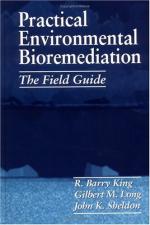|
This section contains 1,232 words (approx. 5 pages at 300 words per page) |

|
Bioremediation is the use of organisms to break down and thereby detoxify dangerous chemicals in the environment. Plants and microorganisms are used as bioremediators. The technology can take advantage of a natural metabolic pathway or genetically modify an organism to have a particular toxic "appetite."
Natural Microbial Bioremediators
On March 24, 1989, an oil tanker called the Exxon Valdez crashed into a reef in the Prince William Sound in Alaska, spilling 11 million gallons of oil that devastated the highly populated ecosystem. Attempts to clean rescued animals and scrub oily rocks were of little help and actually killed some organisms. Bioremediation was more successful. Ten weeks after the spill, researchers from the U.S. Environmental Protection Agency applied phosphorus and nitrogen fertilizers to 750 oil-soaked sites. The fertilizer stimulated the growth of natural populations of bacteria that metabolize polycyclic aromatic hydrocarbons, which are organic toxins that were present in the spilled oil...
|
This section contains 1,232 words (approx. 5 pages at 300 words per page) |

|


